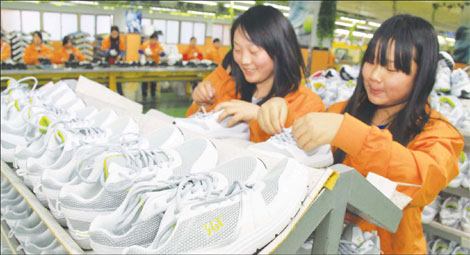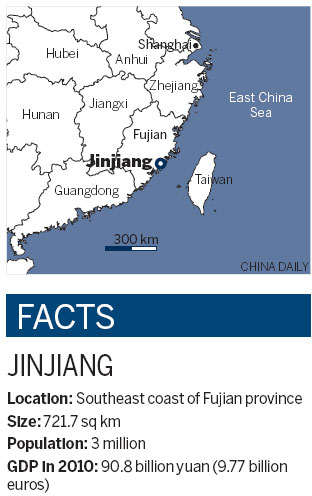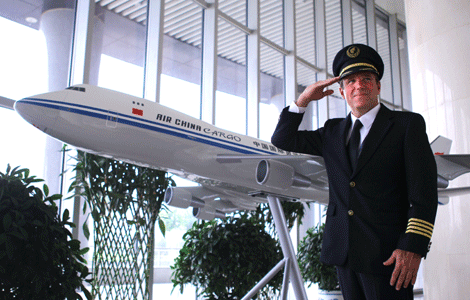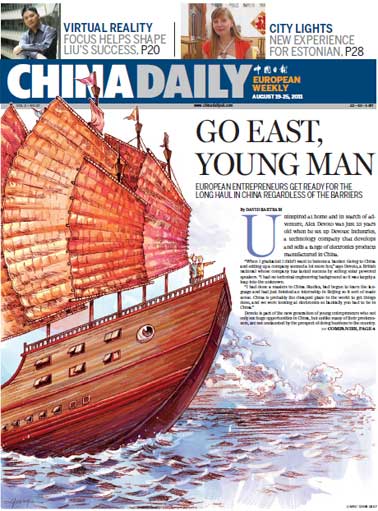Stepping on to success
Updated: 2011-04-01 10:53
(China Daily European Weekly)
Sports shoes makers in Sportswear hub gear up for European market
When Ding Shizhong set up a sports shoes company in 1991 with 20,000 yuan (2,180 euros) in his hometown Jinjiang, in East China's Fujian province, the high school dropout probably never imagined he would become the founder and CEO of a leading sportswear company in China.

Workers in a factory of 361 Degrees International Ltd check the quality of shoes. The company is one of many Jinjiang sportswear enterprises trying to position themselves for the next stage of business. Zhu Xingxin / For China Daily |
Ding began selling sports shoes when he was 17 and the 41-year-old is now the owner of ANTA Sports Products Ltd, a company worth more than 25 billion yuan (2.71 billion euros).
ANTA is just one of the 1,300 sportswear companies in Jinjiang, known as the capital of sports shoes in China. The small county located in southeastern Fujian is home to nearly half of China's and 20 percent of the world's sports shoes production.
The development of its sports shoes industry has helped fuel Jinjiang's prosperity for the past two decades. In 2010, the county's GDP hit 90.8 billion yuan, ranking it No 6 among China's counties. Nearly 30 percent of the GDP came from the shoe industry.
Because of the density of its sports shoes brands, Jinjiang's regular shoes exhibition has also become a major event in China. Beginning from 1999, the exhibition is the major platform for domestic and overseas sports shoes producers and dealers to showcase the latest technologies and look for business opportunities. This year, the exhibition will take place on April 18, with 1,600 exhibition positions for 965 companies at home and abroad, organizers say.
The success of Jinjiang, a city with a total area of 721.7 square km and population of about 3 million, offers a look at how family-run Chinese enterprises can grow into a cluster of industry brands and how residents in an area without natural resources can set up their own businesses.
"The land itself could not support the residents and our people decided to set up some businesses instead," says Lin Yonghong, vice-chief of Jinjiang's economic development bureau.
"That was in the late 1970s, when reform and opening-up were launched," Lin says. "Producing sports shoes was already an industry that required less input and technology at that time."
Lin Tuqiu was considered the first person in Jinjiang to produce shoes. In 1979, he started his shoe-making at home with a hammer, a pair of scissors, a table and several sewing machines. Back then, China suffered from a shortage of materials and residents readily welcomed Lin's shoes.
"People had to line up to buy my shoes and the price of a pair of 40-yuan shoes would be raised to 50 yuan after they went to the dealers," Lin says. The average monthly salary of Jinjiang residents was 30 yuan at that time.
Lin's success inspired many Jinjiang residents to take up shoe making and factories were established one after another.
But the first generation of Jinjiang's businessmen did not create their own brands.
They were shoemakers who set up workshops, produced shoes from pre-established models and sold them to domestic and gradually, overseas markets.
"The shoes did not have brands. Some of them did not even have names. They were mostly referred to by the name of the factories they came from," Lin Yonghong says.
In the early 1990s, foreign sports shoes entered the Chinese market and Jinjiang shoemakers found it more profitable to be in the OEM (original equipment manufacturer) business. Overnight, all the shoes produced in Jinjiang were tagged to global makes like Nike, adidas and Puma.
Lin says it was not until the late 1990s when the shoemakers recognized the limitations of OEM and began to realize the importance of having their own brands.
"You can say Jinjiang people are good imitators because they follow other people's patterns of success," Jinjiang Mayor Liu Wenru says.
"But I should say they have also become good initiators. There is no county in China like Jinjiang that has generated so many sportswear brands and they are all family-run," Liu says.
Jinjiang sportswear brands started to emerge in the late 1990s and early 2000s. It was also the time when overseas brands like Nike and adidas expanded their Chinese markets.
To compete with the international brands, Jinjiang businessmen chose a different way of taking market share.
"As newly established brands, we knew we lacked of popularity and the most important thing was to build up a customer base," says Hou Chaohui, vice-general manager of 361 Degrees International Ltd (361). Founded in 2003, the company positioned its market in second- and third-tier cities in China.
"We focus on the working class of the third- and fourth-tier cities. It is true that the consumer competence of the first-tier cities is attractive, but that is only represented by a small number of people," Hou says. "In the third- and fourth -tier cities, however, our products with relatively reasonable prices are more welcomed."
International brands like Nike and adidas have emphasized the high-end market since they entered the Chinese market and they have been considering targeting the lower end so that more Chinese people can afford their products, but that would be very risky because they might lose their high-level consumers, Hou says.
"Imagine, when residents in counties and towns in China start wearing Nike and adidas, many high-end consumers will abandon the brands," Hou says. "On the other hand we are taking up the whole third- and fourth-tier markets."
After eight years of practicing its market positioning strategy, 361 now has 7,240 shops and the figure is expected to hit 8,000 by the end of this year.
Like 361, most of the Jinjiang sportswear companies have been developing this way. ANTA now has more than 8,000 stores in China and most of them are in second- and third-tier cities.
As they built their brands, Jinjiang sports shoes companies also faced the problems during the OEM days - copying from international brands. To change the image of "Made in China" to "Created in China", the companies in Jinjiang turned to research and development.
ANTA established a national technology center in 2009 with an area of 8,000 square meters. Its R&D expenditure has exceeded 3 percent of its sales revenue each year.
|
 Mayor Liu Wenru says local people are good imitators and have also become good initiators. Lai Xiaobing / For China Daily |
By the end of 2009, ANTA owned 43 patents on sports shoes and sportswear. The company also cooperates with institutes in Britain, France, Belgium and Germany. In the first half of 2010, it promoted more than 1,700 types of new sports shoes.
"We believe R&D competence will be a core element in future market competition and we will focus more on technology and design innovation," ANTA's Ding says.
Other leading companies like 361 and Hongxing Erke have also established research centers and own several patents in sports shoes.
But Hou of 361 thinks the R&D expenditure of Jinjiang companies is still far from enough.
Jinjiang companies waited until 2009 to realize the importance of R&D, while the international brands have been aware of this "for decades".
"It will take at least two to three years for us to catch up with famous international brands like Nike and adidas, and if the R&D expenditure keeps at 3 to 5 percent of the sales revenue, the time will be longer," Hou says.
Another challenge for Jinjiang sportswear companies is the restructuring of management. Most Jinjiang sportswear companies are private enterprises and run by family members.
"Family-run companies themselves do not have any problems, but there will be many problems when the companies are totally managed by families, because when family members are involved, the decisions-making process will be more difficult and less rational," Ding says.
By getting listed on domestic or overseas stock markets, leading sportswear companies in Jinjiang started restructuring by employing professional managers as early as 2005.
"The advantage of a family-run company is that the owners will try to maintain long-term development of their company, while professional managers help to maximize short-term profits," Hou says.
But defining the boundaries between the company owner and the professional manager so that the managers are motivated to do their best while the owner still has a say in the company is an issue that has to be resolved for Jinjiang companies.
Jinjiang sportswear companies seem to have different strategies for going international.
|
 |
Hongxing Erke has already taken its first step to expand overseas. The company has been in the European market for more than three years, with about 300 stores in Europe now.
"The European market is the most important one among our overseas markets," says Li Yuanwen, director of the international business department of Hongxing Erke. Li says the company has been taking part in the ISPO Munich industry event for five years, and a customer base has been established.
But 361 is still emphasizing its domestic market. "Right now, we have to focus our resources on the domestic market which is still promising," Hou says.
While only a few companies have been taking steps to go international, Jinjiang sportswear companies seem to be preparing for further development by moving their headquarters out of Jinjiang.
As a county-level city, Jinjiang lacks a comprehensive public transportation system and other supporting facilities. "The infrastructure of Jinjiang is far behind its economic development and that does not fit the big companies' images. Also, it leads to the result that talented people are not willing to come here," says Lin Yonghong of Jinjiang's economic development bureau.
"The government has long realized the imbalance, but did not expect that the development of industries like sports shoes, textile and ceramics would be much faster than the city's infrastructure," Lin says.
"Some say the big companies are moving out and Jinjiang is dying. I do not agree," Jinjiang Mayor Liu Wenru says.
"We are making every effort to make the city deserving of the title of a 'capital of brands'," Liu says. "As long as people have to live, they have to wear shoes and clothes, and our traditional industries in shoe-making and clothing will always have markets."
E-paper

Pearl paradise
Dreams of a 'crazy' man turned out to be a real pearler for city
Literary beacon
Venice of china
Up to the mark
Specials

Power of profit
Western companies can learn from management practices of firms in emerging economies

Foreign-friendly skies
About a year ago, 48-year-old Roy Weinberg gave up his job with US Airways, moved to Shanghai and became a captain for China's Spring Airlines.

Plows, tough guys and real men
在这个时代,怎样才"够男人"? On the character "Man"
